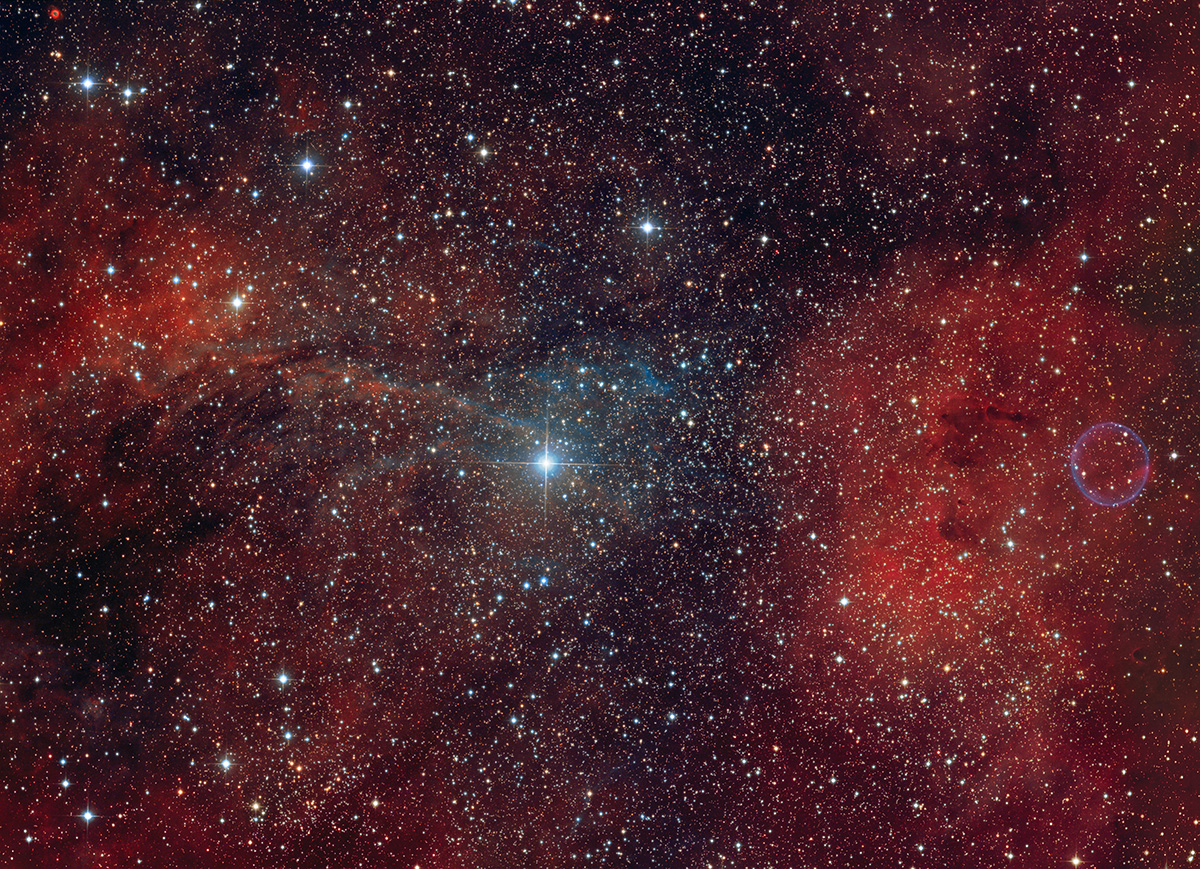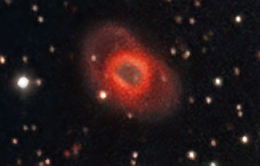
[back] "The Lord of The Rings"
PN G75.5+1.7 (Ju 1), Abell 69 and P Cygni in Cygnus
Higher resolved image / Höher aufgelöstes Bild (3350 x 2426 Pixel)

|
(c) 2019 All astro photo images are copyrighted. They may not be used or reproduced without explicit written permission from the authors. |
|
5' |
|
About this Image / Über dieses Bild
| CCD: | ZWO ASI094MC Pro and SBIG STL-11000M |
| Image Type, Orientation: | RGB-HaOIII Composite, North is at 12:05h |
| Exposure time: | ZWO ASI094MC Pro: RGB: 25x300sec., HaOIII:48x300sec. SBIG STL-11000: Ha: 12x300 sec. (7h5min total) |
| Exposure date: | ZWO ASI094MC Pro: July 9th..29th 2019 SBIG STL-11000: July 7th 2018 |
| Location: | Capella Observatory at Eifel, Germany, remote-controlled from Bad Arolsen/Germany |
| Filter: | ZWO ASI094MC Pro:
RGB: Internal Bayer-Matrix plus
Astronomik L UV-IR Block Typ 2c, Ha/OIII:
STC Astro Duo-Narrowband Filter SBIG STL-11000: Baader 13nm Ha filter |
| Instrument: | Ganymed 60cm-Hypergraph in primary focus (f=1815.9 mm) |
|
Image seeing (FWHM): |
~2.0" |
| Photographer: | Josef Pöpsel, Max Pöpsel, Stefan Binnewies, Frank Sackenheim |
| Remarks: |
P Cygni at the
image center is a luminous blue variable star (LBV) at 6000 to 7000 light
years distance. The hypergiant star of spectral type B2 Ia is one of the
brightest stars of our Milky Way - even so it is dimmed by a surrounding
dust cloud (see
here), which is not visible in the image above due to its visble size of
less than 0.5 arc seconds. 1600 P Cygni had an extreme outburst. Weather it
causes the Ha and OIII bellow visible in the image is uncertain. Even though much smaller as Ju1 Abell 69 (~60" incl. its halo) is known a bit longer. It is first mentioned in G.O. Abells catalog published in 1966. The image below shows Abell at 100% resolution. This tiny little thing should be a target in secondary focus during perfect seeing some day... |
|
Bemerkungen: |
P Cygni in der Bildmitte ist ein leuchtkräftiger blauer Veränderlicher (LBV)
in 6000 bis 7000 Lichtjahren Entfernung. Der Hyperriese vom Spektraltyp B2
Ia ist einer der hellsten Sterne der Milchstraße - er wird aber abgedunkelt
von einer ihn umgebenden Staubwolke (siehe z.B.
hier) , die in der Aufnahme oben aufgrund ihrer scheinbaren Größe von
weniger als 0.5 Bogensekunden nicht zu sehen ist. 1600 hatte P Cygni einen
extremen Helligkeitsausbruch. Ob er der Ursprung der im Bild zu sehenden Ha-
und OIII-Schwaden ist, ist nicht klar. Der PN rechts ist Ju 1, den wir bereits 2008, kurz nach seiner Entdeckung im Sekundärfokus belichtet haben. Wir "tauften" ihn damals "Seifenblasennebel", eine Bezeichnung, die sich nun, 11 Jahre später, in der Astronomiegemeinde etabliert hat. Seit 2013 heißt PN G75.5+1.7 offiziell nach seinem Entdecker Ju1(Jurasevich 1). Etwas länger bekannt, obwohl viel kleiner als Ju1 ist Abell 69 (ca. 60" inkl. Halo), der von G.O. Abell 1966 veröffentlicht wurde. Das Bild unten zeigt Abell 69 in 100%. Dieser Winzling wird im Sekundärfokus bei perfektem Seeing sicher noch einmal aufs Korn genommen werden müssen... |
Abell 69 in 100%

(c) 2019 All astro photo images are copyrighted by the authors
Back to the Planetary Nebulae Overview / Zurück zur Planetarische-Nebel-Übersichtsseite